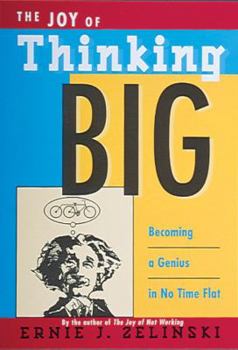The Joy of Thinking Big
This text is a stimulating resource book designed to help readers profit from creativity in their lives. Packed with fun exercises and insightful observations, it explains how creative thinking can... This description may be from another edition of this product.
Format:Paperback
Language:English
ISBN:0898159806
ISBN13:9780898159806
Release Date:March 1998
Publisher:Ten Speed Press
Length:184 Pages
Weight:0.90 lbs.
Dimensions:0.6" x 6.8" x 9.8"
Customer Reviews
2 ratings
Insight Into Creativity
Published by Thriftbooks.com User , 18 years ago
Few will question that creativity is one of the most powerful assets a person can have. Yet, as this author observes, it is a strange, but a very real paradox that individuals and companies most in need of this priceless asset are, in fact, most resistant to learning how to acquire it. He believes creativity can be learned if your mind is open. He notes how creative children are, but how various forces in our culture destroy this gift of creativity in early childhood. He starts out by giving seventeen principles of creativity. He does this in plain, everyday English and he totally avoids, throughout the book, the gobbledygook and pure verbiage of too many of today's "serious" books on the subject. He notes that advanced formal education is often the enemy of creativity. He feels the average MBA (Masters degree in Business Administration) is not highly creative. In support of this view, he quotes Lee Iaccoca (former Chrysler chairman) as saying "MBAs know everything and understand nothing." The author cites "the four great brain robbers": society, educational institutions, organizations, and ourselves. He details how each of these pressure our minds toward conformity. They instill the belief that there exists one best solution to a problem, whereas an open mind can often find and consider twenty alternate solutions to a problem. Some well known puzzles are offered as mind stimulators; for instance, the classic puzzle as to how to connect nine dots (in a square array) with just four lines without lifting your pencil. In addition there are many fresh puzzles and many techniques for avoiding "idea killers" such as VOJ (Voice Of Judgment). Such judgments are freely offered by others and sadly even by ourselves. As an example, he cites how the Kellogg brothers, years ago, offered a cold cereal to a nation that regarded a hot cereal as the accepted norm. "Experts" derided it as "Horse Food." Think about that when you sit down to your next bowl of "corn flakes." One interesting method for generating ideas is the "idea tree." This involves making a simple sketch that anyone can make and it enables you to visualize solutions to problems. This can be superior to nonvisual methods. Another simple but powerful tool, credited to Edward de Bono, is the PMI list method. You list the Plus, Minus, and Interesting points when analyzing a problem. This method often enables you to look at problems from an outside view and users of the method are often surprised as to how their initial opinions are altered. The frequently given advice that you must write down your ideas as soon as possible is repeated in the book. The author notes that today people are discovering many ideas occur while exercising and that having a note pad handy in your locker or with you while bicycling is advice worth acting on. The author discusses the value of failures, the importance of being different (eccentrics live longer!), and the serious use of humor. He also notes the value of be
A fun read.
Published by Thriftbooks.com User , 24 years ago
I liked this book. The author's effervescent enthusiasm bounces off the page and he passes along practical ideas for improving one's own creativity. Layout of the book is attractive with plenty of white space on each page. Good use of cartoons and inspirational quotes in the margins.Chapter titles show a creative flair: "How to be Creative and Write Graffiti," "How to be a Successful Failure," "Creative Thinking is an Exercise in Silliness," "Be a Creative Loafer now and Zen."At times the author becomes a tad self-indulgent, but that can be forgiven. The editor of this book should have probably said: "Let's do a haircut-trim on those few paragraphs there."The bibliography is a bit short. "What, no web sites listed in the bibliography?" Subtract a half-point from the grade of this book.All in all, a fun read. A truly creative book about creativity.Phil Shapiro, pshapiro@his.com





